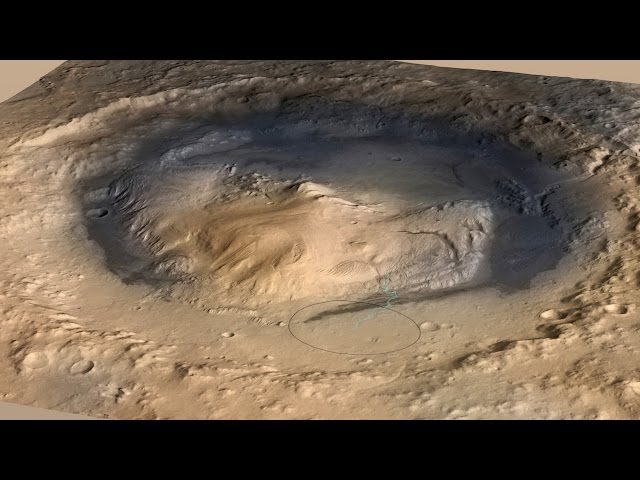Did Mars long ago develop far enough for life to arise? If so, does anything still live within Mars' dusty plains, beneath its ice caps, or somewhere underground?
In 1964 the Mariner Four spacecraft flew by Mars and got a good look. What it saw looked more like the Moon than the Earth. Then, in the mid-1970's, two lander-orbiter robot teams, named Viking, went in for an even closer look. The landers tested the soil for the chemical residues of life. All the evidence from Viking told us: Mars is dead. And extremely harsh.
The mission recorded Martian surface temperatures from -17 degrees Celsius down to -107. We now know it can get even colder than that at the poles. The atmosphere is 95% carbon dioxide, with only traces of oxygen. And it's extremely thin, with less than one percent the surface pressure of Earth's atmosphere.
And it's bone dry. In fact, the Sahara Desert is a rainforest compared to Mars, where water vapor is a trace gas in the atmosphere. On Earth, impact craters erode over time from wind and water... and even volcanic activity. On Mars, they can linger for billions of years.
Earth's surface is shaped and reshaped by the horizontal movement of plates that make up its crust driven by heat welling up from the planet's hot interior. At half the width and only 11% the mass of Earth, Mars doesn't generate enough heat to support wide-scale plate tectonics.
Nor does it have the gravity to hold a thick atmosphere needed to store enough heat at the surface to allow liquid water to flow. Nonetheless, some areas that looked to Viking-era scientists like craters and volcanic areas, were later shown to be riverbeds, lake bottoms, and ocean shorelines.
If water once flowed on Mars' surface, where did it all go?
This was the scene at NASA's Jet Propulsion Lab in 2004. The twin rovers Spirit and Opportunity had just bounced down on the Red Planet. When the excitement died down, the rovers were set off on one of the most remarkable journeys in the history of planetary exploration. Missions like this could one day pave the way for a day when we'll view images from a real astronaut's camera.
Opportunity had come to rest in a small crater near the equator, at a spot called Meridiani Planum. Here, in plain view, on a nearby crater wall, its camera revealed exposed bedrock, the first ever seen on Mars. Not far away, the rover found layered rocks on the face of a cliff. On Earth, they typically form as sedimentary layers at the bottom of oceans.
And at every turn, Opportunity rolled across tiny, smooth, round pellets. They became known as "blueberries" because they appeared purplish-brown against Mars' rust-colored surface. Initially thought to be volcanic in origin, they turned out to be iron-rich spherules of the type that form within cavities in the mud at the bottom of an ocean.
Drilling into rocks, the rover inserted a spectrometer to read the mineral content. The readings showed significant amounts of sulfate salt, a tracer for standing water. That wasn't all. Spirit's broken wheel, dragging behind it, exposed soils saturated in salt.
Clearly there once was water on Mars' surface, but how long ago? And, if there is anything left, where would you find it? One possible answer: the North Pole. From orbit, this region seemed to be covered in frozen CO2 - what we call dry ice. But was there water ice below the surface?
Enter Phoenix, a lander that touched down near the North Pole in early 2008. Radar readings from orbit, taken by the Mars Express mission, hinted at the presence of ice just below the surface.
The Phoenix lander's descent thrusters blew away the top layer of soil, allowing its camera to snap pictures of what looked like ice. Scientists instructed the robot to conduct a simple experiment: reach out and dig a trench, then watch what happens.
As expected, clumps of white stuff appeared. A couple of days later, it was gone. Vaporized. That means it can't be salt or frozen CO2, which is stable in the cold dry temperatures of the Martian pole. So it had to be water, the first ever directly seen on Mars.
There are indications that the North Pole was actually warm enough in the recent past for water ice to become liquid. The Mars Reconaissance Orbiter, or MRO, used radar pulses to peer beneath the surface of the ice cap. These data reveal that the ice, just over a mile thick, formed in a succession of layers as the climate alternated between warm and cold.
Our planet avoids mood swings like this in part because its spin is stabilized by a massive moon. Mars' spin is not, so it can really wobble, with the pole tilting toward the sun for long periods. New observations by the MRO spacecraft show that these wobbles can lead to dramatic releases of CO2, and warming periods due to an increase in the greenhouse effect.


